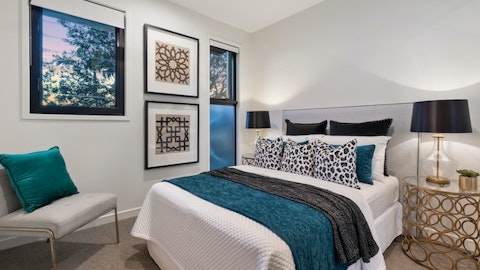Rafe Jadrosich: Got it. Okay. That’s helpful. And then just in the fourth quarter guidance implies a deterioration in Mineral Fiber volume growth versus the 2019 level, compared to the third quarter. And we’re not losing a selling day year-over-year in the fourth quarter. The guidance sort of implies actually worse year-over-year growth despite the easiest comp. Does the guidance still assume deterioration in economic activity from here? What are you seeing kind of 3Q to date and sort of what’s implied in that guidance from an end demand outlook.
Chris Calzaretta: Yes. Sure. So it assumes a market that’s down called in that low single-digit range, which is pretty consistent with what we’ve seen throughout the course of this year. And then as Vic and I both mentioned, it assumes that retail, call it home center volume coming out in the fourth quarter. So that’s really the top line. And then as it pertains to EBITDA, again, a little bit heavier SG&A as we’re lapping a period where we saw some benefits on incentive comp last year, higher incentive comp this year and then a little bit of promotional spend associated with some new product launches, which drives that kind of that EBITDA walk for you.
Rafe Jadrosich: Great. Thank you. Very helpful.
Chris Calzaretta: You’re welcome.
Operator: Your next question comes from the line of Kathryn Thompson from Thompson Research Group. Your line is open.
Kathryn Thompson: Hey, thanks for taking my question today. Just one on the JV did a little bit better than expectations and understanding, I just want to get a little bit of better understanding of the driver for that? And in particular, are there any new growth initiatives within the JV that are really finally contributing to the overall earnings.
Vic Grizzle: Yes. Very similar, I think, to our Mineral Fiber business, Kathryn, the market backdrop, the volume was better than expected. I think that was a nice contributor, but they’re doing a nice job in continuing to manage their steel purchases and their steel inventory levels and the pricing around that to make sure that we’re driving margins back to where they need to be. The team is doing a good job overall operationally, contributing to that. So I think it’s those building blocks probably in an outsized way, just a better market backdrop than that was initially expected.
Kathryn Thompson: Okay, and thanks for that. And then I know you touched on this, but I just want to pull string a little bit more on this. You talked about just a better end market mix contributing to – especially to Mineral Fiber. How easy or difficult, given the current market conditions, is it to do that? And then also how do you – how does one differentiate and not necessarily on the tile side, but just kind of the combination of what you’re able to provide. How has that contributed to overall a little bit better performance other than just the broad market which you’ve touched on?
Vic Grizzle: I don’t sure understand your question. Are you talking about. I’m sorry, go ahead.
Kathryn Thompson: Well, really, how easy or difficult is it to shift your end market mix? End market mix. And how easy is that? Or is it just like to draw like mix for the end market just happened to be better? Or is this more a concerted effort on your end?
Vic Grizzle: Well, we’re present with the architects that are driving all of these end market specifications. So we can support the architects where they have the work and where they have the business. And again, that’s a really important asset of ours is to have this presence in the architectural community because their workload shifts based on the market activity and we’re connected to them at the hip and making sure that we’re supporting on those types of projects. So I’d say it’s fairly easy for us to move where the market activity is going because of our presence and our strong seat at the table with the architects.
Kathryn Thompson: Okay, great. Thanks very much.
Vic Grizzle: You bet.
Operator: Your next question comes from the line of John Lovallo from UBS. Your line is open.
John Lovallo: Good morning, guys. Thank you for taking my questions as well. I guess the first one, Vic, you talked about maybe a little bit of choppiness in the market, some stabilization in certain markets. But if we think about on the Mineral Fiber side, the 2% to 4% volume target through 2026. Any updated thoughts there on the ability to achieve that?
Vic Grizzle: Well, I think the building blocks are still there. You’re referring to the 2% to 4% longer-term growth rate in Mineral Fiber; remember the building blocks there were a market recovery back to 2019 levels and then one to two points of contribution from our growth initiatives. Again, we still expect there’s nothing structurally change to the point that we don’t think we’re going to get back to 2019 volume levels. And as we’ve reported in this quarter, we’re getting some nice contribution to the high end of that one to two point range for our growth initiatives. So my thoughts, and we’re not in a position to change that outlook at this point. It may get pushed out some depending on when the market recovery becomes part of that equation. But all the building blocks, John, are still there for us to get back to a 2% to 4% Mineral Fiber growth level.
John Lovallo: Okay. That’s helpful. And then when we think about Canopy and the higher win rate that you’re experiencing there, curious what do you think is driving that? I mean, I guess a couple of questions. How sustainable do you think it is? Who are you competing against? And is it really just that underserved as a market where there’s this longer-term runway?
Vic Grizzle: Yes. No, I think on the Canopy platform, we’re demonstrating that there is an underserved customer out there that doesn’t know where to go to get their ceiling tiles renovated and frankly, they think it’s very expensive to do. They’re finding out that it’s not that hard to do or giving them a place to go and to transact. And so – and the type of customers that are coming to this site and buying from us are not typical Armstrong customers. These are customers that don’t know Armstrong for the most part and don’t know where to go to get ceiling tiles. And we’re creating this cost-effective way to reach out, educate them, make them aware and help them get this done in a very easy way. It’s kind of the easy button, if you will, is the Canopy by Armstrong platform.
Your reference to the win rate is more with our project works, my comments around project works. We’re adding value here to these designs that architects are developing. We’re helping them to iterate more productively, they can do this in a matter of days versus weeks. And we’re strengthening our ability to – strengthen the specification, if you will, and that’s improving our win rate on projects as they go through the channels, from the GCs to the contractors, all the way down through distribution. So that was my reference is we’re adding value here. We’re driving incremental both volume and AUV growth through this value-added service. And our traction in the A&D community is continuing to grow. So we’re in the early innings of this, but we’re really encouraged by the incrementality of such an automated design tool.
John Lovallo: Understood. Thank you very much.
Vic Grizzle: Thank you, John.
Operator: Your final question comes from the line of Adam Baumgarten from Zelman & Associates. Your line is open.
Adam Baumgarten: Hey, good morning, everyone. Just curious on the volume trends across the product suite, Mineral Fiber throughout the quarter. Anywhere where it is particularly strong or weak across either high or low end or kind of mid-range type products? And then just on mix within the segment, was that a more impactful positive this quarter versus maybe the prior few quarters?




